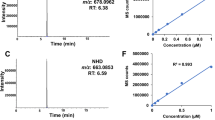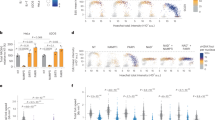Abstract
Dihydronicotinamide riboside (NRH) has been suggested to act as a precursor for the synthesis of NAD+, but the biochemical pathway converting it has been unknown. Here, we show that NRH can be converted into NAD+ via a salvage pathway in which adenosine kinase (ADK, also known as AK) acts as an NRH kinase. Using isotope-labelling approaches, we demonstrate that NRH is fully incorporated into NAD+, with NMNH acting as an intermediate. We further show that AK is enriched in fractions from cell lysates with NRH kinase activity, and that AK can convert NRH into NAD+. In cultured cells and mouse liver, pharmacological or genetic inhibition of AK blocks formation of reduced nicotinamide mononucleotide (NMNH) and inhibits NRH-stimulated NAD+ biosynthesis. Finally, we confirm the presence of endogenous NRH in the liver with metabolomics. Our findings establish NRH as a natural precursor of NAD+ and reveal a new route for NAD+ biosynthesis via an NRH salvage pathway involving AK.
This is a preview of subscription content, access via your institution
Access options
Access Nature and 54 other Nature Portfolio journals
Get Nature+, our best-value online-access subscription
$29.99 / 30 days
cancel any time
Subscribe to this journal
Receive 12 digital issues and online access to articles
$119.00 per year
only $9.92 per issue
Buy this article
- Purchase on Springer Link
- Instant access to full article PDF
Prices may be subject to local taxes which are calculated during checkout








Similar content being viewed by others
Data availability
Relevant data generated or analysed during this study are included in this article (and its Supplementary Information files). Unpublished data that support the findings of this study are available from the corresponding author upon request. Source data for Figs. 1, 3, 5 and 8 are presented with the paper.
References
Yang, Y. & Sauve, A. A. NAD+ metabolism: bioenergetics, signaling and manipulation for therapy. Biochim. Biophys. Acta 1864, 1787–1800 (2016).
Rajakumar, K. Pellagra in the United States: a historical perspective. South Med. J. 93, 272–277 (2000).
Wilder, R. M. A brief history of the enrichment of flour and bread. JAMA 162, 1539–1541 (1956).
Kornberg, A. & Lindberg, O. DPN pyrophosphatase. Fed. Proc. 7, 165 (1948).
Kornberg, A. The participation of inorganic pyrophosphate in the reversible enzymatic synthesis of diphosphopyridine nucleotide. J. Biol. Chem. 176, 1475 (1948).
Preiss, J. & Handler, P. Enzymatic synthesis of nicotinamide mononucleotide. J. Biol. Chem. 225, 759–770 (1957).
Preiss, J. & Handler, P. Biosynthesis of diphosphopyridine nucleotide. II. Enzymatic aspects. J. Biol. Chem. 233, 493–500 (1958).
Preiss, J. & Handler, P. Biosynthesis of diphosphopyridine nucleotide. I. Identification of intermediates. J. Biol. Chem. 233, 488–492 (1958)..
Bogan, K. L. & Brenner, C. Nicotinic acid, nicotinamide, and nicotinamide riboside: a molecular evaluation of NAD+ precursor vitamins in human nutrition. Annu. Rev. Nutr. 28, 115–130 (2008).
Sauve, A. A. NAD+ and vitamin B3: from metabolism to therapies. J. Pharmacol. Exp. Ther. 324, 883–893 (2008).
Gholson, R. K., Ueda, I., Ogasawara, N. & Henderson, L. M. The enzymatic conversion of quinolinate to nicotinic acid mononucleotide in mammalian liver. J. Biol. Chem. 239, 1208–1214 (1964).
Nishizuka, Y. & Hayaishi, O. Enzymic synthesis of niacin nucleotides from 3-hydroxyanthranilic acid in mammalian liver. J. Biol. Chem. 238, 483–485 (1963).
Bieganowski, P. & Brenner, C. Discoveries of nicotinamide riboside as a nutrient and conserved NRK genes establish a Preiss-Handler independent route to NAD+ in fungi and humans. Cell 117, 495–502 (2004).
Gomes, A. P. et al. Declining NAD+ induces a pseudohypoxic state disrupting nuclear-mitochondrial communication during aging. Cell 155, 1624–1638 (2013).
Katsyuba, E. & Auwerx, J. Modulating NAD+ metabolism, from bench to bedside. EMBO J. 36, 2670–2683 (2017).
Canto, C. et al. The NAD+ precursor nicotinamide riboside enhances oxidative metabolism and protects against high-fat diet-induced obesity. Cell Metab. 15, 838–847 (2012).
Gariani, K. et al. Eliciting the mitochondrial unfolded protein response by nicotinamide adenine dinucleotide repletion reverses fatty liver disease in mice. Hepatology 63, 1190–1204 (2016).
Zhang, H. et al. NAD+ repletion improves mitochondrial and stem cell function and enhances life span in mice. Science 352, 1436–1443 (2016).
Barbosa, M. T. et al. The enzyme CD38 (a NAD glycohydrolase, EC 3.2.2.5) is necessary for the development of diet-induced obesity. FASEB J. 21, 3629–3639 (2007).
Bai, P. et al. PARP-1 inhibition increases mitochondrial metabolism through SIRT1 activation. Cell Metab. 13, 461–468 (2011).
Khan, N. A. et al. Effective treatment of mitochondrial myopathy by nicotinamide riboside, a vitamin B3. EMBO Mol. Med. 6, 721–731 (2014).
Cerutti, R. et al. NAD+-dependent activation of Sirt1 corrects the phenotype in a mouse model of mitochondrial disease. Cell Metab. 19, 1042–1049 (2014).
Gong, B. et al. Nicotinamide riboside restores cognition through an upregulation of proliferator-activated receptor-gamma coactivator 1alpha regulated beta-secretase 1 degradation and mitochondrial gene expression in Alzheimer’s mouse models. Neurobiol. Aging 34, 1581–1588 (2013).
Hou, Y. et al. NAD(+) supplementation normalizes key Alzheimer’s features and DNA damage responses in a new AD mouse model with introduced DNA repair deficiency. Proc. Natl Acad. Sci. USA 115, E1876–E1885 (2018).
Sorrentino, V. et al. Enhancing mitochondrial proteostasis reduces amyloid-beta proteotoxicity. Nature 552, 187–193 (2017).
Xu, W. et al. Lethal cardiomyopathy in mice lacking transferrin receptor in the heart. Cell Rep. 13, 533–545 (2015).
Zhang, R. et al. Short-term administration of nicotinamide mononucleotide preserves cardiac mitochondrial homeostasis and prevents heart failure. J. Mol. Cell Cardiol. 112, 64–73 (2017).
Tummala, K. S. et al. Inhibition of de novo NAD+ synthesis by oncogenic URI causes liver tumorigenesis through DNA damage. Cancer Cell 26, 826–839 (2014).
Das, A. et al. Impairment of an endothelial NAD+-H2S signaling network is a reversible cause of vascular aging. Cell 173, 74–89 e20 (2018).
Trammell, S. A. et al. Nicotinamide riboside is uniquely and orally bioavailable in mice and humans. Nat. Commun. 7, 12948 (2016).
Dellinger, R. W. et al. Repeat dose NRPT (nicotinamide riboside and pterostilbene) increases NAD+ levels in humans safely and sustainably: a randomized, double-blind, placebo-controlled study. NPJ Aging Mech. Dis. 3, 17 (2017).
Dollerup, O. L. et al. A randomized placebo-controlled clinical trial of nicotinamide riboside in obese men: safety, insulin-sensitivity, and lipid-mobilizing effects. Am. J. Clin. Nutr. 108, 343–353 (2018).
Airhart, S. E. et al. An open-label, non-randomized study of the pharmacokinetics of the nutritional supplement nicotinamide riboside (NR) and its effects on blood NAD+ levels in healthy volunteers. PLoS One 12, e0186459 (2017).
Martens, C. R. et al. Chronic nicotinamide riboside supplementation is well-tolerated and elevates NAD+ in healthy middle-aged and older adults. Nat Commun. 9, 1286 (2018).
Yang, Y., Mohammed, F. S., Zhang, N. & Sauve, A. A. Dihydronicotinamide riboside is a potent NAD+ concentration enhancer in vitro and in vivo. J. Biol. Chem. 294, 9295–9307 (2019).
Megarity, C. F. et al. The two common polymorphic forms of human NRH-quinone oxidoreductase 2 (NQO2) have different biochemical properties. FEBS Lett. 588, 1666–1672 (2014).
Miller, R. L. et al. Adenosine kinase from rabbit liver. II. Substrate and inhibitor specificity. J. Biol. Chem. 254, 2346–2352 (1979).
Ugarkar, B. G. et al. Adenosine kinase inhibitors. 1. Synthesis, enzyme inhibition, and antiseizure activity of 5-iodotubercidin analogues. J. Med. Chem. 43, 2883–2893 (2000).
Jarvis, M. F. et al. ABT-702 (4-amino-5-(3-bromophenyl)-7-(6-morpholinopyridin-3-yl)pyrido[2, 3-d]pyrimidine), a novel orally effective adenosine kinase inhibitor with analgesic and anti-inflammatory properties: I. In vitro characterization and acute antinociceptive effects in the mouse. J. Pharmacol. Exp. Ther. 295, 1156–1164 (2000).
Berger, F., Lau, C., Dahlmann, M. & Ziegler, M. Subcellular compartmentation and differential catalytic properties of the three human nicotinamide mononucleotide adenylyltransferase isoforms. J. Biol. Chem. 280, 36334–36341 (2005).
Grozio, A. et al. Slc12a8 is a nicotinamide mononucleotide transporter. Nat. Metab. 1, 47–57 (2019).
Giroud-Gerbetant, J. et al. A reduced form of nicotinamide riboside defines a new path for NAD+ biosynthesis and acts as an orally bioavailable NAD+ precursor. Mol. Metab. 30, 192–202 (2019).
Boison, D. & Yegutkin, G. G. Adenosine metabolism: emerging concepts for cancer therapy. Cancer Cell 36, 582–596 (2019).
Yang, T., Chan, N. Y. & Sauve, A. A. Syntheses of nicotinamide riboside and derivatives: effective agents for increasing nicotinamide adenine dinucleotide concentrations in mammalian cells. J. Med. Chem. 50, 6458–6461 (2007).
Li, W. & Sauve, A. A. NAD+ content and its role in mitochondria. Methods Mol. Biol. 1241, 39–48 (2015).
Acknowledgements
This work was funded in part by NIH grant GM R01-106072 (A.A.S.) and from NY Spinal Cord Research Board Contract C32098GG (A.A.S.).
Author information
Authors and Affiliations
Contributions
Y.Y. and A.A.S. developed the concept and study design; Y.Y. investigation; Y.Y. and A.A.S. writing, original draft; Y.Y. and A.A.S. writing, review and editing; N.Z., Y.Y. and A.A.S., synthesis and isotope methodology; G.Z. and Y.Y., proteomics and metabolomics analyses; A.A.S., obtaining funding.
Corresponding author
Ethics declarations
Competing interests
The authors A.S. and Y.Y. have filed a published PCT patent WO 2017/011788 Al on aspects of NRH activities in conjunction with Cornell University. A.S. is a co-inventor of issued US patent 8,106,184, that is related to methods to produce NR and derivatives. This patent is licensed by Chromadex Inc of Irvine California. A.S. is a consultant and a co-founder of Metro MidAtlantic Biotech and Metro International Biotech. The authors N.Z. and G.Z. declare no competing interests.
Additional information
Peer review information Primary handling editor: Christoph Schmitt.
Publisher’s note Springer Nature remains neutral with regard to jurisdictional claims in published maps and institutional affiliations.
Extended data
Extended Data Fig. 1 Known NAD+ biosynthetic pathways in mammalian cells.
The currently known NAD+ biosynthetic pathways in mammalian cells.
Extended Data Fig. 2 Structures of inhibitors and pathways of NRH metabolism.
a) Structures of AK inhibitors. b) The “NRH salvage pathway”, where NRH is transported across cell membrane, phosphorylated into NMNH by NRH kinase, then adenylated into NADH which is then oxidized to produce NAD+. Additional pathways such as nicotinamide salvage, dependent upon Nampt (FK866 sensitive) and Nrk1 dependent pathways are also depicted in the unshaded part of the Scheme. Modified from Scheme published in reference 35.
Supplementary information
Supplementary Information
Supplementary Figures 1–4 and Table 1
Source data
Source Data Fig. 2
Unprocessed silver staining gel
Source Data Fig. 3
Unprocessed Western Blots
Source Data Fig. 5
Unprocessed Western Blots
Source Data Fig. 8
Unprocessed Western Blots and gel
Rights and permissions
About this article
Cite this article
Yang, Y., Zhang, N., Zhang, G. et al. NRH salvage and conversion to NAD+ requires NRH kinase activity by adenosine kinase. Nat Metab 2, 364–379 (2020). https://doi.org/10.1038/s42255-020-0194-9
Received:
Accepted:
Published:
Issue Date:
DOI: https://doi.org/10.1038/s42255-020-0194-9
This article is cited by
-
NAD+ Precursors Nicotinamide Mononucleotide (NMN) and Nicotinamide Riboside (NR): Potential Dietary Contribution to Health
Current Nutrition Reports (2023)
-
Importance of NAD+ Anabolism in Metabolic, Cardiovascular and Neurodegenerative Disorders
Drugs & Aging (2023)
-
Porcine placental extract increase the cellular NAD levels in human epidermal keratinocytes
Scientific Reports (2022)
-
Gut microbiota severely hampers the efficacy of NAD-lowering therapy in leukemia
Cell Death & Disease (2022)
-
Balancing NAD+ deficits with nicotinamide riboside: therapeutic possibilities and limitations
Cellular and Molecular Life Sciences (2022)



